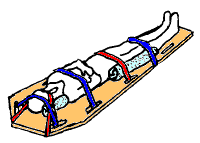Long spine board
| Spinal board | |
|---|---|
| Intervention | |

Spine immobilization with a long spine board
|
|
| Synonyms | long spine board (LSB), long back board, spineboard, backboard |
A spinal board, is a patient handling device used primarily in pre-hospital trauma care.
It is designed to provide rigid support during movement of a person with suspected spinal or limb injuries. They are most commonly used by ambulance staff, as well as lifeguards and ski patrollers. Historically, backboards were also used in an attempt to "improve the posture" of young people, especially girls.
Due to lack of evidence to support long-term use, the practice of keeping people on long boards for prolonged periods of time is decreasing.
The spinal backboard was originally designed as a device to remove people from a vehicle. After a time people were simply kept on the spine board for transport without evidence supporting this need.
A spinal board is primarily indicated for judicious use to transport people who may have had a spinal injury, usually due to the mechanism of injury, and the attending team are not able to rule out a spinal injury. The person should be transferred from the board to a hospital bed as soon as possible. For comfort and safety reasons, it is recommended to transfer the patient to a vacuum mattress instead, in which case a scoop stretcher or long spine board is just used for the transfer.
Despite its history of use, there is no evidence that backboards significantly immobilize the spine, nor do they improve patient outcomes. Additionally, cervical spine immobilization has been shown to increase mortality in patients with penetrating trauma and can cause pain, agitation, respiratory compromise, and can lead to the development of bedsores.
Common clinical issues found with spinal boards include pressure sore development, inadequacy of spinal immobilization, pain and discomfort, respiratory compromise and effects on the quality of radiological imaging. For this reason, some professionals view them as unsuitable for the task, preferring alternatives.
It is advised that no patient should spend more than 30 minutes on a spine board, due to the development of discomfort and pressure sores.
Backboards were invented to be a "highly polished surface" to move a person to an EMS bed, not to be used as spinal securing device.
...
Wikipedia
